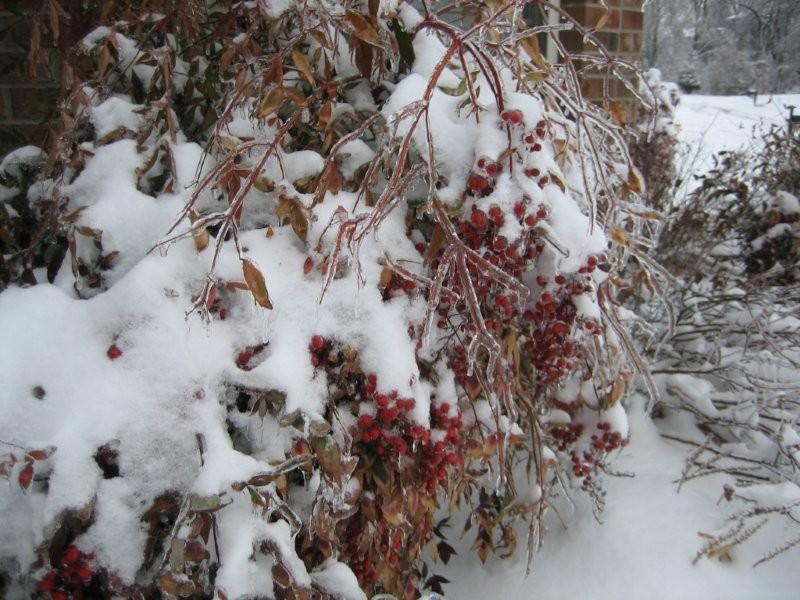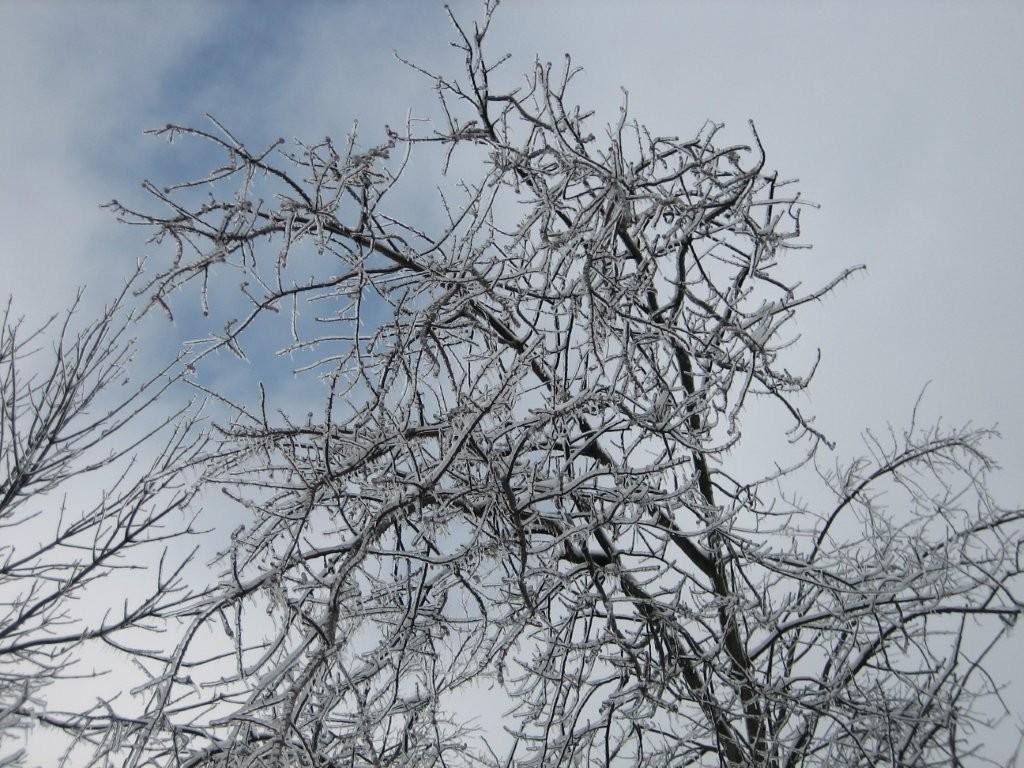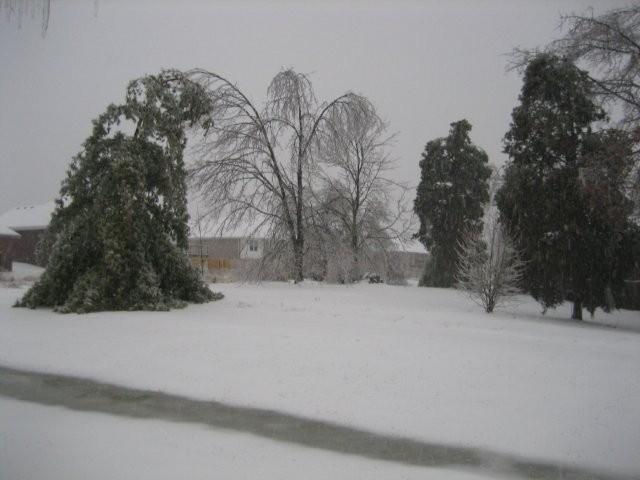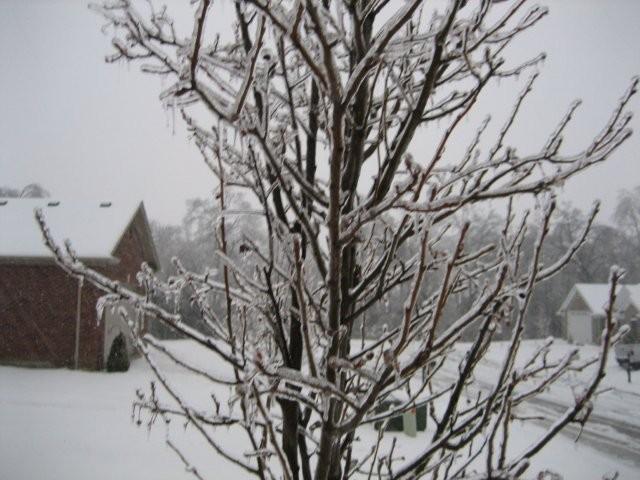
2009-01-31 1615: For the first time since the ice storm began, it's now above freezing. Things seem to be melting. The weather service has a special weather statement posted that warns of the danger of falling ice. They also note, "the melting and falling of ice can also cause trees and power lines to spring back quickly." They are predicting a low of 33 for tonight, and a high of 45 for tomorrow, so hopefully things will melt rapidly.
Meanwhile, Duke Energy reports that there are only 335 customers in Floyd County who still haven't had their power restored, and 2,321 for their entire southern Indiana service area. This compares with 19,000 and 51,000 on Wednesday (if memory serves).
2009-01-30 1500: I am grateful that my power hasn't gone out since the storm. There remain about 4,500 Duke Energy customers in Floyd County without power (down from about 19,000), and Duke says they will have everyone restored by 11:00 p.m. tomorrow (except for scattered outages). So, north of the Ohio River, they are making good progress in dealing with this disaster. But apparently, south of the river, things are worse: They are talking about mid February until everyone is restored; there were 600,000 people without power in Kentucky, at least as many as the record outage caused by the remnants of Hurricane Ike last September.
While I've been hanging around at home (the university has been closed since Tuesday), I've spent a little time reading about emergency power and heat options. I learned that one can have a natural gas-fired stand-by generator installed, which can power your whole house, and which will automatically turn on in the event of a power outage. This would be the best option, but it costs $4,000 to have one installed, which is a lot of money for an appliance that would be used for several days only once every few years. I thought of getting a natural gas fireplace installed. I'm not sure how much it would cost; $2,000 installed? The advantage there is that it would be pleasant to have in non-emergency situations. The disadvantage is that it provides only heat, and rather expensive and inefficient heat at that. My Mom tells me that it cost $300 to keep their house warm for four days when they had an ice-storm power failure some years ago. But my brother Tom told me all I need is a kerosene-burning space heater. These cost $120, and can keep a small house tolerably warm (burning 2 gallons of fuel a day). I think I might get one of these after things return to normal (and the stores have them back in stock); or possibly a propane-fueled space heater (which might be easier to use). But at any rate, I do not want to go through another disaster of this kind unprepared. Even though I was fortunate this time, I still had quite a bit of anxiety and stress as I watched the freezing rain accumulate.
2009-01-28 1345: The snow ended by 10:30 a.m. or so. I had about 2.5 inches (6 cm) of snow on top of the existing 3 inches of sleet-snow-ice, so there was about 5.5 in (14 cm) total accumulation. The sun has come out but it's in the mid 20s F now, so the ice isn't going away very soon.
I still have power, thankfully, but one colleague of mine lost power before 7 a.m.; and worse, he had a tree fall on his roof, causing damage. He lives in a leafy neighborhood a couple of miles south of me. Duke Energy reported 19,000 customers without power in my county. They expect to be working into the weekend to restore everyone's power. It appears that my area was the worst-hit by the storm (Floyd and Clark Counties, which are across the Ohio River from Louisville, Kentucky).
I took some more pictures. Ice storms are an unusual natural disaster in that they can be rather beautiful.



2009-01-28 0830: The ice on the ground (on top of yesterday's 3 inches of sleet and snow) was 0.5 inches thick (13 mm). A couple of pictures:


2009-01-28 0800: The freezing rain has just switched over to snow. They're calling for 3-5 inches by noon, when it's supposed to end. The freezing rain lasted all night. We got quite a bit of ice. I can't tell how much (I haven't left the house), but it looks like half an inch or more. The trees near my house are bent under the weight of the ice. The good news for me is that I still have power. But there are 14,000 people in my county (Floyd County) who do not have power, and 51,000 in the Duke Energy service area in southern Indiana.
2009-01-27 1710: They are now predicting an inch of ice this evening, with potentially devastating impacts. I hiked to school this afternoon, and the sleet turned to freezing rain by the time I returned. It froze on my parka, and crackled as I walked. I think we've had a quarter of an inch so far.
2009-01-27 1330: It turns out we got about 3 inches (8 cm) of sleet and snow. The precipitation began last night at about midnight as sleet; later it changed to snow, but this morning it changed to freezing rain and sleet. Right now, there is freezing rain and sleet, and it's 26 degrees. They're predicting it will change back to snow overnight; we are under a winter storm warning through tomorrow morning. I'm enjoying a day off, although I think I might hike into school for the exercise (and to get a little work done).

2009-01-26 0840: I thought it might be a good idea to buy tire chains this morning, so I can get around if the snow proves to be bad and it sticks around for a while. But I am told tire chains are illegal in Indiana. This perplexes me. In Portland, Oregon, not only are they legal, but they were required for several days during their winter storm last month.
2009-01-26 0800: After all of the snow last month in Portland, now it looks like Louisville's turn: We are under a winter storm warning for tonight through Tuesday night. The forecast is for 3-5 inches tonight and an additional 4 inches tomorrow.
2009-01-23 2145: I was sorry to hear about my sister and her family's bad experience at the inauguration. They happen to live in northern Virginia, so they had a good chance to go to the inauguration. They had "silver" tickets, which should have enabled them to get into the Mall to get a reasonably good view of the inauguration, at least on the Jumbotron TV screens. Unfortunately, the police appeared to be woefully underprepared for the tremendous number of people who tried to get into the Mall, and my sister and her family were unable to get into the Mall. In fact, they were worried for their safety—the press of the crowd got so bad they were afraid they would get suffocated. With difficulty they turned back. They were astonished to see vast crowds of people still heading towards the Mall at 11:30 AM, people who were still unaware they had no chance of getting there.
2009-01-21 2200: Today the small bookshelf speakers I ordered (Polk Audio RTiA1 speakers) arrived from Amazon. I found the following advice in the owner's manual:
| [The power rating of your speakers] does not imply the speaker will safely handle that full amount of power on a long-term basis … Automobile horsepower is a good analogy. Your car probably has far more horsepower than it needs for your daily commute and is likely capable of going well over 120mph (190km/hr). Having that extra power is good for on-ramp acceleration and danger avoidance (like getting away from brain-eating zombies) but that doesn't mean that it is advisable to operate your car on North American highways at full power and maximum speed for an extended period of time. Just ask your local state trooper if you are in doubt. |
2009-01-20 2245: I just watched some of the Inauguration ceremony again, having recorded it on my DVR. (I saw it live on campus, with a large group of students and several colleagues.) It was incredible seeing all of the people on the Mall. The Joni Mitchell lyric came to mind: By the time we got to Woodstock, we were half a million strong, and everywhere there was a song and a celebration. In this case, it was more like two million, but there was most definitely song and celebration. The Aretha Franklin performance of "My Country 'Tis of Thee" was beautiful. The ABC News commentator mentioned that this song was referred to by Martin Luther King in his "I Have a Dream" speech in 1963:
And this will be the day -- this will be the day when all of God's children will be able to sing with new meaning:
My country 'tis of thee, sweet land of liberty, of thee I sing.
Land where my fathers died, land of the Pilgrim's pride,
From every mountainside, let freedom ring!
And if America is to be a great nation, this must become true.
|
The only disappointment in the ceremony was the Rick Warren invocation, which was, I thought, sectarian in an entirely inappropriate way. But I was deeply impressed when President Obama referred to "a nation of Christians and Muslims, Jews and Hindus—and non-believers." It's worth quoting the entire paragraph this came from:
| For we know that our patchwork heritage is a strength, not a weakness. We are a nation of Christians and Muslims, Jews and Hindus—and non-believers. We are shaped by every language and culture, drawn from every end of this Earth; and because we have tasted the bitter swill of civil war and segregation, and emerged from that dark chapter stronger and more united, we cannot help but believe that the old hatreds shall someday pass; that the lines of tribe shall soon dissolve; that as the world grows smaller, our common humanity shall reveal itself; and that America must play its role in ushering in a new era of peace. |
And I was grateful to hear Obama say that [we] will restore science to its proper place.
2009-01-18 1930: I'm considering dropping my cable digital TV service, which costs about $75 per month, so I decided to try to see how well I can receive HD broadcasts over the air with my old antenna. (HD broadcasts are transmitted on UHF channels, by the way, so you use the loop-type antenna instead of the rabbit ears to receive HD channels.) Apparently, I can receive all the Louisville channels clearly. But I didn't know what channels the HD stations are broadcasting on. I searched in vain on the web for channel listings for Louisville, Kentucky. This was frustrating because all I seem to be able to get Google to give me were listings for the local cable company. Channel listings do not seem to be available on the FCC website, or not in a usable form. Finally, I found out my own TV will list all the channels, including station call letters. (I had to get my TV to scan all channels. It took some doing to figure out how to navigate the resulting list of channels.) Anyway, after all of this, I now know what channels my TV can receive (it's possible there are other digital TV broadcasts in Louisville that my TV couldn't find):
| Channel | Call letters | Network |
| 3-1 | WAVE DTV | NBC |
| 3-2 | thisTV | [no content being broadcast] |
| 3-3 | Weather | WAVE Weather |
| 11-1 | WHAS | ABC |
| 15-1 | KET1 | PBS |
| 15-2 | KET2 | PBS |
| 15-3 | KET HD | PBS |
| 15-4 | KET ED | PBS |
| 32-1 | WLKY DT | CBS |
| 41-1 | WDRB DT | Fox |
| 58-1 | WMYO DT | Fox |
2009-01-16 2300: This evening I saw the Louisville Orchestra perform the John Adams piece Grand Pianola Music. This is a wonderful piece of music. As I mentioned on my earlier post (January 7), this is a minimalist composition that reaches a high level of musical energy culminating in a romantic, singing melody. The piece is scored for various wind and brass instruments, percussion, three amplified female vocalists, and two grand pianos. This was interesting to see set up on the stage: The winds and brass were set back well behind the pianos, which were in the front and center together; the vocalists were on stage left. I greatly enjoyed the performance; the only disappointment was the peculiar acoustics where I sat—I was in the first row in front of the stage, towards the right, and the brass were loud but the pianos sounded muted. That was the penalty for getting a cheap seat, but I did get a good view of one of the pianists at his keyboard.
The concert began with two other pieces: Mozart's Symphony No. 35 (the "Haffner"), and the Suite in F Sharp Minor by Ernö Dohnányi. I'm not a big fan of Mozart but this symphony was pleasant; the Dohnányi piece was warm and enjoyable. I was glad to hear all three pieces, but I was grateful to be able to attend the performance of the John Adams piece.
2009-01-16 2245: I was sorry to read that the artist Andrew Wyeth passed away. He was 91. I saw some of his "Helga" paintings some years ago, and I was deeply impressed by the emotion and beauty of those paintings.
2009-01-16 0745: It was -1 F (-18 C) when I got up this morning. This was at the airport; my thermostat read -2 at 7 am. This isn't quite as cold as the all-time record low for Louisville: -22 (recorded January 19, 1994). I think the last time it was this cold in Louisville was in 2004, when it reached -5.
2009-01-14 2345: There are ominous reports about the health of Steven Jobs, co-founder of Apple. One Apple insider says Jobs is in denial about his health. I feel very bad about this; I've always had a soft spot in my heart for Apple. I hope and pray that Jobs recovers.
2009-01-14 2330: Mr. Obama has nominated William V. Corr, the executive director of Campaign for Tobacco-Free Kids, for Deputy Secretary of Health and Human Services. This appears to violate the letter of Obama's transition rule to not nominate lobbyists for government service—but not the spirit of the rule. Corr has promised to recuse himself from issues related to tobacco regulation, but I hope that his nomination signals that the Obama Administration is serious about fighting the tobacco industry.
2009-01-13 0830: The New York Times has two particularly interesting articles on scientific topics: One article, A Breakthrough in Imaging: Seeing a Virus in Three Dimensions, concerns a new MRI-like technique called magnetic resonance force microscopy that achieves a resolution of 4 nanometers (an atom is typically 0.1 nanometer in diameter). The new technique is not destructive of the viral particles it images, and shows their three-dimensional structure. The article has an impressive picture of tobacco mosaic virus particles on the end of a metal probe.
The other article (Data Analysts Captivated by R's Power) is on R, an open-source statistical programming language rapidly gaining popularity among researchers at universities and in industry. I've become enthusiastic about R, having been using it for the last several months for the infant feeding project I've been participating in. I must credit Prof. Albyn Jones of Reed College for introducing me to the language, and Joe Hollingsworth (a colleague of mine at IU Southeast) for bringing my attention to the article.
2009-01-12 2300: Andrew Sullivan today had an interesting excerpt from a Douglas Murray essay, Studying Islam has made me an atheist, of December 29, 2008 in Spectator.co.uk (this was in Sullivan's blog entry of January 11, 9:55 am). I reproduce this here with two readers' comments because together they parallel some of my own thoughts on Christianity in the last year or two. First, Douglas Murray:
|
Some years ago I started studying Islam. It didn't take long to recognise the problems of that religion's texts—the repetitions, contradictions and absurdities. Unlike Christianity, scholarship on these problems in Islam has barely begun. But they are manifest for anyone to see. For a holy book which in its opening lines boasts 'that is the book, wherein is no doubt', plenty of doubt emerges. Not least in recognising demonstrable plagiarisms from the Torah and the Christian Bible. If God spoke through an archangel to one illiterate tradesman in 7th-century Arabia, then—just for starters—why was he stealing material? Or was he just repeating himself? Gradually, scepticism of the claims made by one religion was joined by scepticism of all such claims. Incredulity that anybody thought an archangel dictated a book to Mohammed produced a strange contradiction. I found myself still clinging to belief in Christianity. I was trying to believe—though rarely arguing—'Well, your guy didn't hear voices: but I know a man who did.' This last, shortest and sharpest, phase pulled down the whole thing. In the end Mohammed made me an atheist. |
Now a comment from a reader who gives his name as "veryscarybiscuits.blogspot.com":
|
So Douglas Murray has gone from being a fundamentalist Christian straight to being a fundamentalist atheist without any intervening moderation? I say fundamentalist because that term applies to any adherent who takes things too literally. Of course it is nonsense to take the bible literally - most language cannot sensibly be interpreted that way, religious texts included. … I am not sure it is possible to be a fundamentalist and an Anglican at the same time. The whole movement what based on a thinking interpretation of holy texts and a rejection of accepting things as just 'given'. The Germanic scholars didn't destroy Christianity by questioning it, they strengthened it enormously and dragged our whole Western civilisation out of the dark ages, where it had been stuck since the collapse of Rome. It is no coincidence that our great universities started as theological colleges and evolved to nuture Newton. The idea of a 'sacred' text is not in its infallability but in its underlying truth. Just because it happens to be true or contains transcription errors does not make it any less holy. Modern thinking Christians do not question the text but, more often, the standard intreptation [sic] of that text, which is often anything but Holy. It is the rejection of temporal authority of the texts (e.g. the Pope) and, by corrolary, an unintermediated relationship with God which is the defining feature of modern Christianity. [December 30, 2008] |
And the first sentence from a comment by a reader who gives their name as DG Enderhart:
| Gosh, our redoubtable author discovers what all the great Church Fathers and mediaeval theologians took for granted: that the Bible is not literally inerrant or true (the fundamentalist reading of the Bible being an invention of the twentieth century); and from that he concludes that there is no God. [December 30, 2008] |
2009-01-08 2345: When I was in the Northwest last month in all of the snow, several friends or acquaintences voiced the fear that flooding would follow. Now there is indeed flooding, in Washington state. MSNBC.com has an arresting photo of floodwaters covering interstate I-5 at Chehalis (which is about an hour north of Portland or two hours south of Seattle). I drove from Portland to Seattle and back on that highway last month. A 20 mile section of the interstate is closed now.
2009-01-07 2145: I've finished a splendid book, The Rest Is Noise: Listening to the Twentieth Century, by the New Yorker magazine music critic Alex Ross. This book is exceptionally well-written and completely fascinating. Ross tells the back stories of many composers, their times and music. He begins with Gustav Mahler and Richard Strauss. He details the music of Claude Debussey, and describes the influence of jazz on early twentieth century classical music. He describes the commotion that Igor Stravinsky's The Rite of Spring caused, and tells of other musical pieces in later decades whose premieres were "scandal concerts." Ross describes Arnold Schoenberg, Anton Webern and Alban Berg, who developed twelve-tone and serial music to break free of tonality, convention and tradition. Ross traces the influence of the "politics of style," as composers reacted to fascism, communism and other political movements; one chapter traces music through the World War Two era in America, Russia and in Germany. He gives prominent coverage to Aaron Copland and Dimitri Shostakovich, as well as the English composer Benjamin Britten. Ross describes the 1950's and 1960's avant-garde and experimental musical scene, as represented by composers such as Györgi Ligeti, John Cage and Olivier Messiaen. Ross also details minimalism (Terry Riley and Steve Reich in particular) and post-minimalism (John Adams); and he concludes with a sketch of the international contemporary music scene, which has many active composers.
I was particularly glad to read this book, since I have lately been listening to a lot more classical music. This book has already inspired me to buy recordings of music that I might never have heard of, such as Messiaen's From the Canyons to the Stars… . I must also credit the clerks at Classical Millenium in Portland, Oregon, who helped me find interesting music. This record store is absolutely incredible, not just because they have an outstanding music selection, but also because their clerks are so knowledgeable. It's a shame that there are no longer any excellent classical music stores in Louisville. Record stores seem to be going by the boards in the current lamentable era of highly-compressed low-fidelity music downloads, but classical stores in particular are hard to find. It seems that every record shop in Louisville has reduced its classical selection to not much more than Beethoven and Mozart, or easy listening. Only the Barnes and Noble on Hurstbourne Lane seems to try to keep a reasonable if modest selection of classical music.
The Louisville Orchestra is going to perform the John Adams piece The Grand Pianola Music this month. I look forward to seeing this concert. This John Adams piece is wonderful. It is scored for chorus, orchestra and two pianos; it begins in a minimalist mode but progresses towards a broad romantic style as it breaks into song, a strong melody performed at full power by the ensemble. This is a particularly good piece of modern classical music for listeners, such as myself, who grew up on rock music.
2009-01-07 2030: I'm safely home from the west coast, but I can't seem to get away from the snow. The evening before my early morning flight, I hoped to have a nice dinner with my Mom. But it started to snow, and because we were afraid the roads would become dangerous, we cut our plans short and had take-out instead. Fortunately, the snow turned to rain later in the evening, and I was able to get to the airport with no problem. But here in Indiana, we have been having light snow showers. No accumulation, but now it's getting colder and windy.
2009-01-04 0245: When I drive from Beaverton to Hillsboro (Oregon), to visit my brother Tom, I happen to drive past a new manufacturing facility for a company called SolarWorld. I was curious about this company. I surmised that this facility was an old computer chip manufacturing plant, converted to make solar panels. But one of my brothers told me that the plant was built from scratch. A friend of mine also told me that this company was connected to Intel, which wants to demonstrate that its ability to mass-produce chips inexpensively will pay off in the solar power market. But it turns out my brother and my friend were both wrong about SolarWorld. SolarWorld is a German company, and their facility in Hillsboro really is an old chip plant, originally owned by Komatsu. (SolarWorld wanted to locate a factory in the US to take advantage of the growing US market for solar power, and they chose Oregon for the plant because Oregon has a large, well-educated workforce with experience in the chip manufacturing industry.) It turns out my friend at Intel was thinking of another company, SpectraWatt, which is also located in Hillsboro.
2009-01-03 1400: I read a little book by Travis Bradford, Solar Revolution: The Economic Transformation of the Global Energy Industry. Bradford is a fund manager and former corporate buyout specialist. He argues that on its own economic merits, photovoltaic solar energy will soon take off, becoming a major source of energy in the world. He believes that fossil fuels will become unreliable and more expensive, while photovoltaic solar will become less expensive. This process would be accelerated if governments subsidize adoption of solar power, but Japan and other countries are already driving the rapid growth of solar (the electricity that comes out of the wall outlet in Japan costs 21 cents per kilowatt hour, which makes solar already competitive with other sources of electricity there). Bradford says that the costs of photovoltaic solar are overstated because solar power can be generated at the location where it is consumed, so the cost of the grid is not relevant. He also says that solar makes the most sense as a source of peak power, available when it is most needed (during the day when air conditioning and commercial demand is highest). He predicts that within ten years, photovoltaic solar will be cheaper than peak power, and in twenty or thirty years, photovoltaic solar will be competitive for base load power (now generated primarily by coal and nuclear); but this will require technical progress in energy storage (in batteries or hydrogen fuel cells). Part of his argument depends on his assessment of other forms of power. He dismisses nuclear as too expensive. But I caught one error: her refers to the "containment failure" of the reactor at Chernobyl. (The Soviet design had no containment vessel, unlike Three Mile Island, which suffered a partial core meltdown but avoided a catastrophic release of radioactivity.) There are other minor editing devils and the like, and the author spends too much time summarizing the basics of energy (pretentiously discussing the energy uses of prehistoric man, for example). But for its flaws, his case for solar is at least plausible.
2009-01-03 1230: I've revamped my website a bit, organizing my blog. If you by any chance have links to things from my website, these might now be broken.